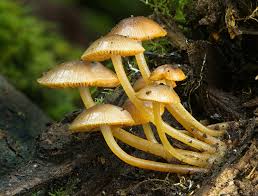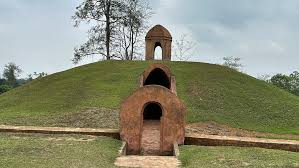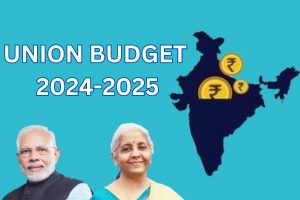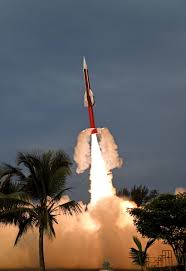Today’s Current Affairs: 24th July 2024 for UPSC IAS exams, State PSC exams, SSC CGL, State SSC, RRB, Railways, Banking Exam & IBPS, etc
Table of Contents
Fungi- Mushroom : Study

A study showed that the ingestion of psilocybin, the hallucinogenic compound present in magic mushrooms, results in a temporary reset of extensive neuron networks in the brain responsible for regulating an individual’s perception of time and self.
- Mushrooms are fungi that typically have a stem, a cap, and gills.
- They are classified as fungi because they lack chlorophyll and cannot produce their food through photosynthesis.
- The fungi constitute a unique kingdom of heterotrophic organisms.
- They are a diverse group of eukaryotic microorganisms or macroscopic organisms that belong to their biological kingdom, distinct from plants, animals, and bacteria.
- Except for unicellular yeasts, fungi are filamentous.
- Fungi have beneficial applications such as yeast in baking and brewing, antibiotic production like penicillin, and culinary uses.
- Fungi prefer to grow in warm and humid places.
- Reproduction in fungi can take place by vegetative means (fragmentation, fission and budding), asexual reproduction (by spores) and sexual reproduction.
- Fungi play a crucial role in preserving the equilibrium of our ecosystem through several key functions like Decomposition, Symbiosis, and Soil enrichment.
Mid-Year Air Quality Assessment For India: CREA

The mid-year air quality assessment for India by the Centre for Research on Energy and Clean Air (CREA), covering the period from January to June 2024, provides a comprehensive overview of the nation’s air pollution levels.
- This report highlights the severity and distribution of air pollution across Indian cities, emphasising the importance of stringent measures to combat this environmental crisis.
Highlights of the Reports:
- Byrnihat, located on the Assam-Meghalaya border, emerged as the most polluted city in India, with an average PM2.5 concentration of 140 µg/m³(Micrograms per Cubic Metre).
- Among India’s top 10 polluted cities, three were in Haryana, two each in Rajasthan and Uttar Pradesh, and one each in Delhi, Assam, and Bihar.
- Delhi ranked as the 3rd most polluted city, with PM2.5 levels at 102 µg/m³, exceeding the National Ambient Air Quality Standards (NAAQS) and World Health Organization (WHO) guidelines.
- Out of 256 cities monitored, 163 exceeded the annual NAAQS (40 µg/m³), while all exceeded the WHO standard (5 µg/m³).
- Among the 97 National Clean Air Programme (NCAP) cities, 63 exceeded the NAAQS.
- Only 63 out of 163 cities exceeding the NAAQS are part of the NCAP, leaving 100 cities without action plans to reduce air pollution.
- The top 10 most polluted cities were spread across 16 states and union territories, indicating the widespread nature of air pollution in India.
- Six new Continuous Ambient Air Quality Monitoring Stations (CAAQMS) were added, increasing the total to 545.
- Karnataka and Maharashtra had the highest number of cities under the “Good” and “Satisfactory” categories, while Bihar had the most cities in the “Moderate” category.
Assam’s Moidams To Be Considered For World Heritage List:

The ‘Moidams’ of Ahom dynasty have been proposed for inclusion in the World Heritage Sites list during the 46th session of the World Heritage Committee.
- India will host this session for the first time in July 2024 in New Delhi.
- UNESCO’s World Heritage list includes 1,199 properties from 168 countries.
- The Moidams represent the late medieval (13th-19th century CE) mound burial tradition of the Tai Ahom Dynasty of Assam.
- These were primarily constructed using earth, bricks, and stone. The outer structure typically consisted of a mound of earth, often surrounded by a brick or stone wall.
- They are the resting place of royal families in Assam’s Charaideo district.
- It enshrines the mortal remains of the members of the Ahom royalty, who used to be buried with their paraphernalia.
- After the 18th century, the Ahom rulers adopted the Hindu cremation method and began entombing the cremated bones and ashes in a Maidam at Charaideo.
- These burial systems of the Ahom dynasty are comparable to the royal tombs of ancient China and the Pyramids of the Egyptian Pharaohs.
Union Budget 2024-2025:

The focus of the budget remains on four major groups: ‘Garib’ (Poor), ‘Mahilayen’ (Women), ‘Yuva’ (Youth), and ‘Annadata’ (Farmers) .
- The Union Budget 2024-25 emphasises employment, skilling, support for MSMEs, and the middle class. A significant allocation of Rs 1.48 lakh crore is earmarked for education, employment, and skilling.
- The budget prioritizes nine areas including agriculture, employment, human resource development, manufacturing, services, urban development, energy security, infrastructure, innovation, research & development, and next-generation reforms.
- Measures include releasing new 109 high-yielding crop varieties, promoting natural farming among 1 crore farmers, establishing 10,000 need-based bio-input bio-input centres, and enhancing production, storage, and marketing of pulses and oilseeds (achieve‘atmanirbharta’ for oil seeds).
- A provision of Rs 1.52 lakh crore has been announced for agriculture and allied sectors this year.
- Government along with the states, will facilitate the implementation of the Digital Public Infrastructure (DPI) in agriculture for coverage of farmers and their lands in 3 years.
- The budget introduces schemes like Employment Linked Incentive and initiatives to boost skilling with a focus on skilling 20 lakh youth over a 5-year period and upgrading 1,000 Industrial Training Institutes.
- Financial support for higher education and loans for skilling are also announced.
- The Model Skill Loan Scheme will be revised to facilitate loans up to Rs 7.5 lakh with a guarantee from a government promoted fund, which is expected to help 25,000 students every year.
- Enhanced support for economic activities among marginalised groups, including tribal communities and women entrepreneurs, is emphasized.
- The government’s Purvodaya initiative aims to comprehensively develop the eastern region of India- including Bihar, Jharkhand, West Bengal, Odisha, and Andhra Pradesh, focusing on human resource development, infrastructure enhancement, and economic growth to advance towards a developed nation.
- The Finance Minister announced the launch of the Pradhan Mantri Janjatiya Unnat Gram Abhiyan to enhance the socio-economic conditions of tribal communities, covering 63,000 villages in tribal-majority areas and aspirational districts, benefiting approximately 5 crore tribal people.
- Over 100 branches of India Post Payment Bank will be established in the North East region to enhance banking services, alongside a provision of Rs 2.66 lakh crore allocated for rural development and infrastructure this year.
- The budget emphasises support for MSMEs, focusing on labour-intensive manufacturing, with a new self-financing guarantee fund offering up to Rs 100 crore per applicant.
- Public sector banks will enhance their internal assessment capabilities for MSME credit. Additionally, Mudra loan limits will increase to Rs 20 lakh for previous ‘Tarun’ category borrowers.
- The budget also includes initiatives like setting up 50 food irradiation units, establishing 100 food quality labs, and creating E-Commerce Export Hubs.
- Furthermore, a scheme for internships in 500 top companies aims to benefit 1 crore youth over 5 years.
- PM Awas Yojana Urban 2.0, has been allocated Rs 10 lakh crore to address housing needs of 1 crore urban poor and middle-class families, with Rs 2.2 lakh crore in central assistance over 5 years.
- The government will also collaborate with State Governments and Multilateral Development Banks to promote water supply, sewage treatment, and solid waste management in 100 large cities through bankable projects.
- Additionally, building on the success of PM SVANidhi, the government plans to establish 100 weekly street food hubs (haats) annually over the next five years.
- PM Surya Ghar Muft Bijli Yojana aims to install rooftop solar plants for free electricity to 1 crore households (up to 300 units every month).
- Nuclear energy is highlighted as a significant part of India’s energy mix.
- Government will try to maintain strong fiscal support for infrastructure over the next 5 years on this line Rs 11,11,111 crore for capital expenditure has been allocated this year, which is 3.4% of our GDP.
- Phase IV of Pradhan Mantri Gram Sadak Yojana (PMGSY) to connect 25,000 rural habitations with all-weather roads due to population growth has been announced.
- For Bihar, under the Accelerated Irrigation Benefit Programme and other sources, the government will allocate Rs 11,500 crore for projects like the Kosi-Mechi intra-state link and 20 other schemes including barrages, river pollution abatement, and irrigation.
- Additionally, financial assistance will be provided to Assam, Himachal Pradesh, Uttarakhand, and Sikkim for flood management, landslides, and related projects.
- The government will establish the Anusandhan National Research Fund to support basic research and prototype development, allocating Rs 1 lakh crore to spur private sector-driven research and innovation at a commercial scale.
- To expand the space economy fivefold in the next decade, a venture capital fund of Rs 1,000 crore will be established.
- Plans for an Economic Policy Framework, labour reforms, and simplification of FDI regulations are outlined to spur economic growth.
- Jan Vishwas Bill 2.0 to improve Ease of Doing Business will be introduced by the government.
International Mathematical Olympiad:

Six-member student teams from India have secured the country its best performance ever in the International Mathematical Olympiad (IMO) 2024.
- International Mathematical Olympiad is the World Championship Mathematics Competition for High School students and is held annually in a different country.
- The first IMO was held in 1959 in Romania, with 7 countries participating. It has gradually expanded to over 100 countries from 5 continents.
- The IMO Board ensures that the competition takes place each year and that each host country observes the regulations and traditions of the IMO.
- The IMO is a self-governing autonomous organization, though it is affiliated to UNESCO. Its Council is elected by participating countries, and is called the IMO Advisory Board.
- The IMO foundation is a charitable organization which accepts donations from organizations which wish to support the IMO.
- This year it was the 65th IMO held at Bath, United Kingdom.
- This is the best performance by an Indian in IMO since the country’s debut in 1989 both in terms of number of Gold medals won and rank achieved.
- The Indian contingent of high school students came in fourth rank globally securing four Gold medals, one silver medal and one honourable mention.
- India’s previous best rank achieved until 2024 was rank 7 at IMO 1998 and IMO 2001.
DIGIPIN:

The Department of Posts has issued a beta version of National Addressing Grid under the brand name of DIGIPIN, which can be used for creating and sensing geo-location of addresses, for public feedback.
- DIGIPIN is an initiative to establish a standardized, geo-coded addressing system in India, for ensuring simplified addressing solutions for citizen-centric delivery of public and private services.
- In this regard, the Department had collaborated with IIT Hyderabad for developing this National Addressing Grid.
- This system will act as a strong and robust pillar of Geospatial Governance, leading to enhancements in public service delivery, faster emergency response and a significant boost to logistics efficiency.
- The DIGIPIN layer will act as the addressing reference system which can be used for logically locating addresses with directional properties built into it due to the logical naming pattern followed in its construction.
- It is proposed to be fully available in the public domain and can be easily accessed by everyone. The DIGIPIN Grid system being an addressing referencing system, can be used as the base layer for other ecosystems, including various service providers and utilities, where addressing is one of the processes in the workflow.
- The advent of DIGIPIN will mark a revolutionary step in India’s journey towards digital transformation by bridging the crucial gap between physical locations and their digital representation.
- The Department has released a beta version of National Addressing Grid ‘DIGIPIN’ for public feedback.
Kalaripayattu:

The Union Minister for Youth Affairs and Sports stated in the Lok Sabha that the Ministry has recognised the Indian Kalaripayattu Federation as the Regional Sports Federation to promote ‘Kalaripayattu’ in the country.
- Kalaripayattu is the traditional martial art originated and popularly practiced in Kerala.
- Mythology has it that the warrior sage Parasurama is the promulgator of Kalaripayattu.
- It is composed of two words, kalari means “place of combat” and payattu means “fighting” in Malayalam.
- The four stages of Payattu are:
- Maippayattu – Body conditioning exercises
- Kolthari – Use of wooden weapons
- Angathari: Use of sharp metallic weapons
- Verumkai : Bare-handed defense and attack.
- Women also underwent training in Kalaripayattu, and still do so to this day.
- The major ethnic style of Kalaripayattu exists in the three regions of northern Kerala (Malabar): Vattenthirippu Style, Arappukkai Style and Pillathangi Style.
- This martial art stands high and gives trainees incredible strength and stamina, defence techniques, auto reflex, flexibility, confidence, concentration, physical culture and mental discipline etc.
- It can be said that Kalarippayattu is Yoga in action.
- This is the only Martial art associated with a treatment branch which can be introduced in the field of sports medicine also.
International Organisation Of Securities Commission:

The International Organisation of Securities Commissions (IOSCO) is now engaged in strengthening the reporting structure of Sustainability and Environment, Social and Governance (ESG).
- International Organisation of Securities Commission was established in 1983.
- It is the international body that brings together the world’s securities regulators and is recognized as the global standard setter for financial markets regulation.
- Objectives:
- Enhance investor protection
- Ensure markets are fair and efficient
- Promote financial stability by reducing systemic risk
- Its objectives and Principles of Securities Regulation are endorsed by both the G20 and the Financial Stability Board (FSB).
- It is a standard setting body with more than 200 members representing 95% of the world’s securities regulators.
- There are three categories of members: ordinary, associate and affiliate.
- Ordinary members, which include the primary futures markets and securities regulators in a given jurisdiction. Each ordinary member has one vote.
- Associate members, consisting of additional futures and securities regulators in those jurisdictions that have multiple regulatory bodies.
- Associate members do not have a vote and aren’t eligible for the Executive Committee, but are members of the Presidents’ Committee.
- Affiliate members, which include self-regulatory organizations, stock exchanges, and stock market industry associations.
- These members do not have a vote and are not eligible for either the Executive Committee or the President’s Committee, but may be members of the Self-Regulatory Organizations (SRO) Consultative Committee.
- The Securities and Exchange Board of Indiais a member to this commission.
- Secretariat: Madrid, Spain.
Air Breathing Propulsion System : ISRO

Indian Space Research Organisation (ISRO) successfully carried out the second experimental flight for the demonstration of Air Breathing Propulsion Technology.
- Air Breathing Propulsion System : this system the rocket will carry its fuel, but will not carry an on-board oxidiser.
- Instead, this system will utilize atmospheric oxygen as an oxidiser to burn the fuel. This makes rockets significantly lighter and more efficient.
- However, such air-breathing technologies can be used only within the denser layers of the Earth’s atmosphere, where there is an adequate supply of oxygen.
- Such technologies might be feasible in the denser layers of Earth’s atmosphere (up to 70 kilometres altitude), and thereafter the rocket must switch to another stage that has both fuel and an on-board oxidizer.
- It is an air breathing propulsion engine operating on the principle of supersonic combustion. It has the absence of any rotator and relies solely on the forward motion of the engine to compress incoming air.
- It is an upgraded version of the Ramjet and generates thrust through supersonic air flow and combustion. It moves at hypersonic speed and performs best at high speeds, greater than Mach 5.
- In 2023, India became the fourth countryto successfully demonstrate the flight testing of a Scramjet Engine.
- It is a jet engine where a ramjet transforms into a scramjet over Mach 4-8 range and it can efficiently operate both in subsonic and supersonic combustor modes.
Economic Survey 2023-24:

Finance Minister Nirmala Sitharaman on Monday tabled the Economic Survey 2023-24 in Parliament, setting the stage for the Union Budget 2024-25 .
- The latest Economic Survey remains bullish on India’s growth and macroeconomic outlook. It pegged India’s GDP growth for FY25 at 6.5-7 per cent and the country’s inflation lower at 4.5 per cent
- India’s real GDP grew by 8.2% in FY24, surpassing the 8% mark in three out of four quarters of FY24.
- Retail Inflation: Retail inflation decreased from 6.7% in FY23 to 5.4% in FY24.
- The CAD improved to 0.7% of GDP in FY24 from 2.0% in FY23.
- Tax Revenue: Direct taxes contributed 55% of the total tax revenue, with indirect taxes making up the remaining 45%.
- Capital Spending: The government progressively increased capital expenditure and provided free food grains to 81.4 crore people.
- Monetary Management and Financial Intermediation – Stability is the Watchword
- Monetary Policy: The RBI maintained a steady policy repo rate at 6.5% throughout FY24.
- Consequently, Core inflation declined by around 4% from April 2022 to June 2024.
- Credit Growth: Credit disbursal by Scheduled Commercial Banks (SCBs) reached Rs 164.3 lakh crore, growing by 20.2% by March 2024.
- Banking Sector: Gross and net non-performing assets are at multi-year lows, and bank asset quality has improved.
- Data from the RBI’s Financial Stability Report of June 2024 show that the asset quality of SCBs has improved, with the Gross Non-Performing Assets (GNPA) ratio declining to 2.8% in March 2024, a 12-year low.
- Insolvency and Bankruptcy Code has been recognised as an effective solution for the twin balance sheet problem, in the last 8 years, 31,394 corporate debtors involving a value of Rs 13.9 Lakh Crore have been disposed off as of March 2024.
- Twin Balance Sheet Problem refers to heavily indebted corporations and banks burdened with bad loans, creating a vicious cycle hindering economic growth.
- Primary capital markets facilitated capital formation of Rs 10.9 lakh crore, approximately 29% of the gross fixed capital formation of private and public corporates in FY23.
- India is poised to become one of the fastest-growing insurance markets and has the second-largest microfinance sector globally.
- Inflation Trends:
- 29 States and Union Territories recorded inflation below 6% in FY24.
- Core services inflation eased to a nine-year low in FY24
- Food inflation increased from 6.6% in FY23 to 7.5% in FY24.
- Price cuts on LPG, petrol, and diesel helped in keeping retail fuel inflation relatively low.
- The RBI forecasts inflation to decline to 4.5% in FY25 and 4.1% in FY26.
- External Sector – Stability Amid Plenty:
- India’s services exports grew by 4.9% to USD 341.1 billion in FY24, with significant contributions from IT/software and other business services.
- India remains the top global recipient, with remittances totaling USD 120 billion in 2023.
- India’s external debt to GDP ratio stood at 18.7% as of March 2024.
- India’s rank in the World Bank Logistics Index improved to 38th in 2023 from 44th in 2014
- India’s share in world tourism receipts increased from 1.38% in 2021 to 1.58% in 2022.
- Healthcare: Over 34.7 crore Ayushman Bharat cards have been issued.
- Housing: 2.63 crore houses constructed under PM-AWAS-Gramin in the past 9 years.
- Youth Unemployment: Fell from 17.8% in 2017-18 to 10% in 2022-23.
- Female Labor Force Participation: Rising for six consecutive years (37.0% currently).
- Pharmaceutical and Clothing Sectors: India’s pharmaceutical market is the world’s third-largest by volume, valued at USD 50 billion.
- It is the second-largest clothing manufacturer globally, with textile and apparel exports reaching Rs 2.97 lakh crore in FY24.
- Digital Services: India’s share in global digitally delivered services exports increased to 6% in 2023.
- Globally, India’s services exports constituted 4.4% of the world’s commercial services exports in 2022 & accounted for 44% of India’s total exports in FY24.
- The pace of National Highways construction increased from 11.7 km per day in FY14 to approximately 34 km per day by FY24.
- Railways: Capital expenditure on Railways increased by 77% over the past five years.
- Aviation: 21 new airport terminal buildings operationalised in FY24.
- Logistics: Rank in the International Shipments category improved to 22nd in 2023 from 44th in 2014.
- Space: India has 55 active space assets, including 18 communication, 9 navigation, 5 scientific, 3 meteorological, and 20 earth observation satellites.




